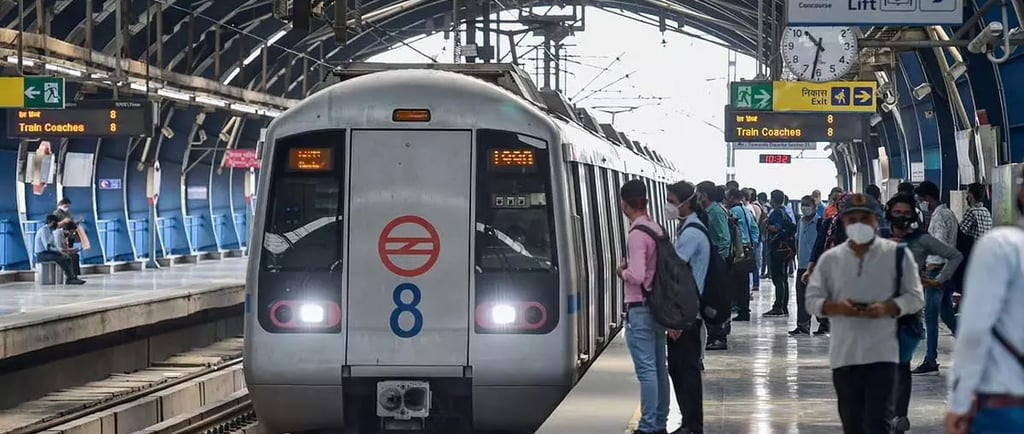Trapped in Transit: The Daily Harassment Women Face on Delhi Metro’s Yellow Line
WOMAN ISSUES


Every morning, my sister and I stand on the platform at GTB Nagar, waiting for the train to take us to our respective destinations. But instead of feeling anticipation for the day ahead, we both feel a tightening knot of anxiety in our stomachs. The Delhi Metro Rail Corporation (DMRC) proudly claims to be the best metro system in India, but for us, and countless other women, it has become a daily ordeal—a journey fraught with fear, discomfort, and harassment.
DMRC assures passengers that trains on the Yellow Line run every 2-3 minutes during peak hours. But in reality, we often wait 4-5 minutes, especially at GTB Nagar, a densely populated area. When the train finally arrives, it’s already bursting at the seams. We force our way in, only to find ourselves pressed against strangers, with no room to move or breathe. It’s an overwhelming crush of bodies, a suffocating experience that leaves us feeling violated before the journey has even begun.
From my sister’s perspective, the experience is even more harrowing.
“Every time I step into the metro,” she says, “I brace myself for what’s to come. The moment I enter, I’m surrounded by men—too close, too many, all pressing against me. There’s no space to escape, no way to shield myself from their touch. I’ve lost count of how many times I’ve been inappropriately touched—sometimes it’s a hand brushing against me, other times it’s more deliberate. And each time, I feel anger, shame, and helplessness.
I’m tired of being told that the front coach is my only safe space. Why should I be confined to one part of the train just to feel secure? I should be able to stand anywhere without fearing for my safety. But instead, I find myself trapped in a daily routine that leaves me feeling violated and vulnerable.”
And she’s not alone in this. Across the country, India reports an average of 90 rape cases every day, according to the Central Pollution Control Board (CPCB). But who talks about the countless incidents of sexual harassment that occur on public transport? The leering eyes, the unwanted touches that women endure every day on the Delhi Metro?
My sister experiences this daily. Who will take responsibility for the men who press against her, who take advantage of the crowded compartments to invade her personal space?
DMRC’s response to our concerns was as disappointing as it was predictable. They informed us that the “available frequency on Line-2 (Yellow line) is as follows: a. Millenium City Centre – Vishwa Vidyalaya peak hour’s headway is 02 min 54 sec (approx.); b. Vishwa Vidyalaya – Samaypur Badli peak hour’s headway is 05 min 48 sec (approx.). This is sufficient to cater to the present traffic demand.” But is it sufficient? For those of us crammed into these trains, it certainly doesn’t feel that way. The frequency may meet their calculations, but it does nothing to ease the discomfort, the suffocation, or the constant fear that haunts women in these overcrowded spaces.
Even with a reserved coach at the front, the problem persists. Why should women be forced into one part of the train just to feel a semblance of safety? Are the other coaches off-limits to us? This limited solution does little to address the broader issue. It isolates the problem rather than solving it, leaving the rest of the train as a free-for-all where women are left vulnerable.
This isn’t just about service schedules or the DMRC’s profitability; it’s about the real lives of women who simply want to travel from one place to another without fear. It’s about the mothers, sisters, and daughters who are subjected to harassment on what should be a safe public transport system. It’s about a society that still allows, and sometimes even ignores, the daily violation of women in public spaces.
We need more than just words and calculated service frequencies. We need action. We need more frequent trains during peak hours, especially in overcrowded areas like GTB Nagar. We need stricter enforcement of anti-harassment measures and a commitment from the DMRC to make every part of the train safe for women.
Until then, every journey on the Yellow Line will be a reminder of how far we still have to go in making public spaces safe for women. The DMRC must do better, not just for my sister, but for every woman who rides the metro, hoping to reach her destination without fear.
